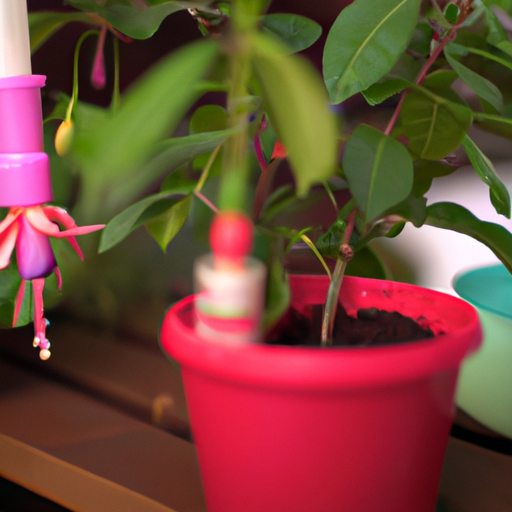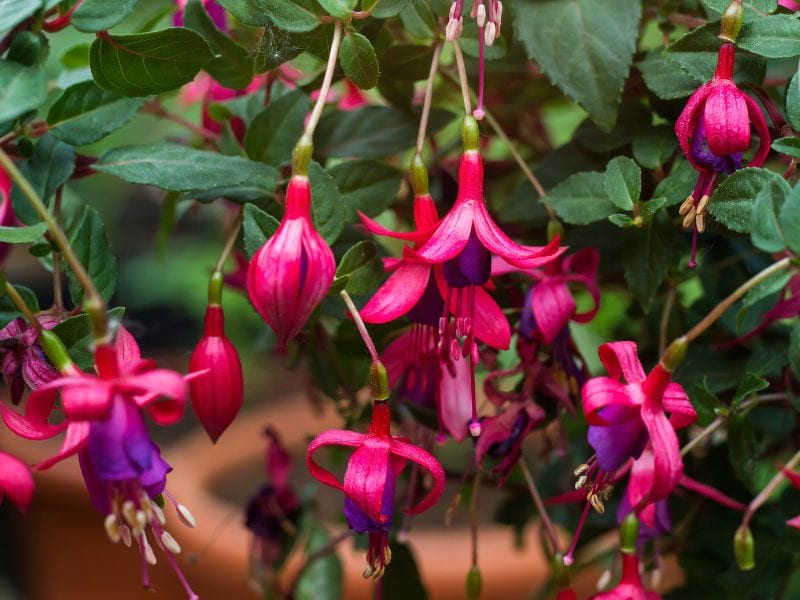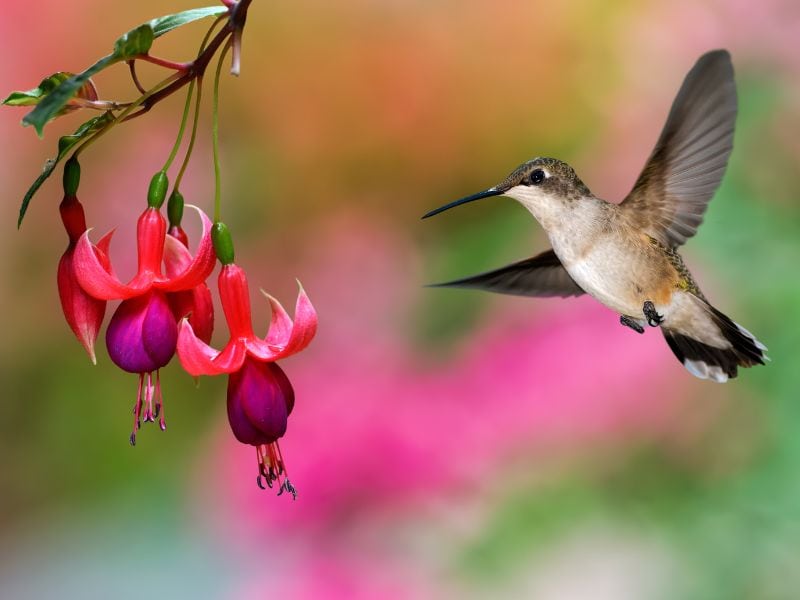Are you looking for a comprehensive plant care guide and specifics on fertilizing fuchsia plants? Keep reading below for everything you need to know about growing this beautiful plant in your garden.
Table of Contents
How to Fertilize Fuchsia Plants for Maximum Blooms

Fuchsia plants are a beautiful addition to any garden, and with the right care, they can produce an abundance of blooms. Fertilizing your fuchsia plants is an important part of keeping them healthy and ensuring they produce plenty of flowers. Here’s how to fertilize your fuchsia plants for maximum blooms.
First, you’ll need to choose the right fertilizer. Look for a fertilizer that is specifically formulated for flowering plants. This type of fertilizer will provide the nutrients your fuchsia plants need to produce lots of blooms.
Next, you’ll need to decide how often to fertilize. Fuchsia plants should be fertilized every two weeks during the growing season. If you’re growing your fuchsia plants in containers, you may need to fertilize more often, as nutrients leach out of the bottom of the pot.
When it’s time to fertilize, mix the fertilizer with water according to the instructions on the package. Then, water your fuchsia plants with the fertilizer solution. Make sure to water the soil around the base of the plant, not getting any on the leaves.
Finally, be sure to monitor your fuchsia plants for signs of over-fertilization. Too much fertilizer can cause the leaves to turn yellow or brown due to excess salts. If you notice any signs of over-fertilization, reduce the amount of fertilizer you’re using or stop fertilizing altogether for a few weeks.
By following these steps, you can ensure your fuchsia plants get the nutrients they need to produce plenty of beautiful blooms. With the right care, your fuchsia plants will be a stunning addition to your garden and the envy of the neighborhood.
Tips for Caring for Fuchsia Plants in Containers
1. Plant your fuchsia in a container with good drainage. Make sure the container has several drainage holes in the bottom.
2. Use a potting mix that is light and airy. A good mix should contain peat moss, perlite, and vermiculite.
3. Place your fuchsia in a spot that gets bright, indirect sunlight. Avoid direct sunlight, as it can scorch the leaves.
4. Water your fuchsia regularly, but don’t over-water. Allow the soil to dry out slightly between waterings.
5. Fertilize your fuchsia every two weeks with a balanced liquid fertilizer.
6. Prune your fuchsia regularly to keep it looking its best. Remove any dead or damaged leaves and stems.
7. Check your fuchsia for pests and diseases. If you notice any, treat them immediately.
8. Repot your fuchsia every two to three years, or when the roots become pot-bound.
Following these tips will help you keep your fuchsia healthy and looking its best!

The Benefits of Using Organic Fertilizers for Fuchsia Plants
Organic fertilizers are a great choice for fuchsia plants, as they provide essential nutrients without much risk of over-fertilizing. Organic fertilizers are made from natural sources, such as animal manure, compost, and plant-based materials. They are slow-release, meaning they provide a steady supply of nutrients over time, rather than a quick burst of nutrients that can be harmful to plants.
Organic fertilizers are also beneficial for fuchsia plants because they help to improve the soil structure. The organic matter in the fertilizer helps to improve the soil’s ability to hold water, which is essential for healthy plant growth. Additionally, organic fertilizers can help to improve the soil’s ability to retain nutrients, which can help to reduce the need for frequent fertilizing.
Organic fertilizers are also beneficial for fuchsia plants because they are less likely to cause nutrient imbalances. Synthetic fertilizers can contain high levels of certain nutrients, such as nitrogen, which can lead to nutrient imbalances in the soil. That’s why it is always important to get a soil test kit and make sure you’re not over or under applying certain nutrients. Organic fertilizers contain a variety of nutrients in more balanced amounts, which can also help to prevent nutrient imbalances if you don’t have access to a good testing kit.
Finally, organic fertilizers are beneficial for fuchsia plants because they are more environmentally friendly than synthetic fertilizers. Synthetic fertilizers can contain chemicals that can be harmful to the environment, while organic fertilizers are made from natural sources and are biodegradable and won’t cause downstream pollution.
Overall, organic fertilizers like Jobe’s Organics are a great choice for fuchsia plants, as they provide essential nutrients without the risk of over-fertilizing, help to improve the soil structure, are less likely to cause nutrient imbalances, and are more environmentally friendly than synthetic fertilizers. Plus they don’t have to be cost prohibitive! Often, you can use homemade ingredients like composted vegetable scraps, egg shells, or coffee grounds to feed your plants.
How to Diagnose and Treat Common Fuchsia Plant Diseases
Fuchsia plants are a popular choice for gardeners due to their vibrant colors and easy care. However, like any other plant, they can be susceptible to disease. Here’s how to diagnose and treat the most common fuchsia plant diseases.
Fuchsia Gall Mite
Fuchsia gall mite is a common disease that affects fuchsia plants. It is caused by a tiny mite that feeds on the plant’s leaves and stems. Symptoms of this disease include distorted leaves, stunted growth, and yellowing of the foliage. To diagnose this disease, look for the presence of small, round galls on the leaves and stems.
To treat this disease, prune off any affected leaves and stems. You can also spray the plant with an insecticidal soap or neem oil to kill the mites.
Powdery Mildew
Powdery mildew is a fungal disease that affects fuchsia plants. It is characterized by a white, powdery coating on the leaves and stems. To diagnose this disease, look for the presence of the white powdery coating.
To treat this disease, prune off any affected leaves and stems. You can also spray the plant with a fungicide to kill the fungus.
Root Rot
Root rot is a fungal disease that affects fuchsia plants. It is caused by overwatering or poor drainage. Symptoms of this disease include wilting, yellowing of the foliage, and stunted growth. To diagnose this disease, look for the presence of soft, brown roots.
To treat this disease, prune off any affected roots and repot the plant in fresh, well-drained soil. You can also spray the plant with a fungicide to kill the fungus.
Related Post: Dealing With Blossom End Rot
Fuchsia plants can be susceptible to disease, but with proper care and treatment, you can keep your plants healthy and vibrant. If you suspect your fuchsia plant is suffering from a disease, take the time to diagnose and treat it as soon as possible. Did you have any success growing your fuchsia plants at home? Snap a picture and share it with us in the comments below!


